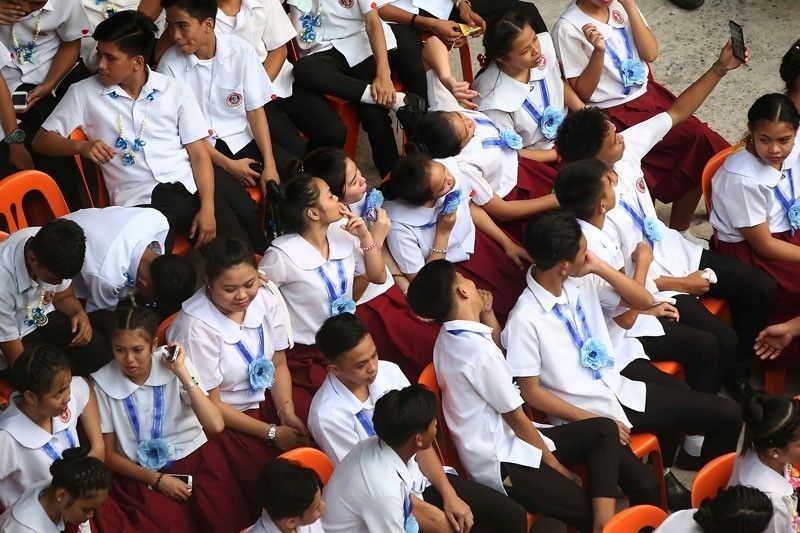Explainer: How the 'K+10+2' system may not address root issues, challenges that hounded K to 12

MANILA, Philippines — The apparent failure of the senior high school program to produce job-ready graduates prompted Deputy Speaker Gloria Macapagal-Arroyo (Pampanga) in April to file a House bill returning high school to four years.
The proposed measure, which would make senior high school mandatory only for college entrants, is seen to dilute the Aquino administration’s flagship K to 12 program that prompted the largest education system overhaul in recent years.
The House basic education committee has yet to formally pass House Bill No. 7893, but panel chair Rep. Roman Romulo (Pasig City) in previous hearings called on lawmakers to be open to the proposal.
But lawmakers and education experts studying international models, as well as professors specializing in education policy, believe that the proposed K+10+2 measure may only be "beneficial in the short-term" and ineffective in solving the country’s education crisis.
DepEd itself has promised to implement changes necessary to improve the quality of the senior high school program, beginning with a review of its curriculum.
Is pivoting to the K+10+2 system a practical and necessary step toward that goal?
Parents, students could be ‘disincentivized’ from proceeding to college
During the Second Congressional Commission on Education (Edcom II)'s meeting on the proposed K+10+2 bill, Sen. Sherwin Gatchalian called on lawmakers, the commission's pool of experts and advisory council members to scrutinize the proposal and its "unintended consequences."
"That’s something I want to put on the table so that we can think about unintended consequences. For me, we might incentivize our kids to stop at Grade 10 and they won’t have the necessary skills [to] land decent jobs in the long run", Gatchalian said, citing a 2022 survey that found most adult Filipinos preferred just ten years of basic education.
By telling the public that finishing senior high is no longer required to find work, low-income families will opt to send their children to eke out a living rather than encourage them to pursue higher or even technical-vocational (tech-voc) education, said Arlyne Marasigan, a professor at the Philippine Normal University
Marasigan added that based on her observation of the education system in China, where she took up her post-doctoral studies in comparative education, the Philippines’ education system is sorely lacking of practical or skills-based training.
"What’s happening in the Philippines is that lawmakers and policy implementors want everyone to go to university. That is not doable. That means we need another kind of preparation in senior high to produce skilled workers who can successfully land a job," Marasigan told Philstar.com in a mix of English and Filipino.
But the government should not make senior high optional now to prevent students from signing away the opportunity for further studies, Marasigan said. "It’s not an issue of how long or how short. It’s how we produce lifelong learners. If we can produce lifelong learners, we can assure that we can offer quality education," she added.
According to its explanatory note, Arroyo’s bill aims to give high school students the option to graduate as soon as possible as "the reality of the market seems to be that the private sector continues to prefer hiring college or university graduates over those who finish the K-to-12 program."
International comparisons: ‘Different faces’ of senior high
A comparison of the Philippines’ senior high school system with those from various countries — specifically Malaysia, Indonesia, Vietnam, Poland, Colombia and Peru — shows that there are at least four diverse "pathways" it can offer to fit the needs of students, according to Pam Robertson of the Assessment, Curriculum and Technology Research Centre (ACTRC).
These are the "general academic, technical/professional, vocational (school-based), and vocational (workplace-based)" pathways, Robertson explained.
Robertson said that these pathways then lead to either further schooling under a university or college, vocational training, or employment.
"International comparisons suggest consideration of the adoption of four pathways for SHS students to cater for a range of abilities and aspirations", Robertson said. "This is likely to impact exit certifications, the SHS curriculum, and teacher education."
The "technical/professional" pathway offers a school-based curriculum that aims to prepare students for both university studies and further vocational training.
This pathway has core academic subjects mixed in with technical electives and "may have small proportion of work-based learning," according to Robertson's presentation.
Meanwhile, vocational pathways in other countries take up two forms: school-based, which includes a mix of general education subjects and vocational subjects and overall prepares students for employment or further vocational training; or work-based, which includes general education subjects and vocational training with "part-time or short, intensive block of learning” to allow all graduates to find a job.
DepEd’s senior high school program currently offers general academic and technical-vocational strands, both of which require some hours of work immersion.
Robertson also emphasized the need for a centralized body for technical vocational training.
"Typically, the vocational pathways are overseen either by the education department or by a single regulatory body. That would mean that an organization like TESDA in the Philippines oversees vocational certifications from secondary right through to all the higher professional qualifications, and that leads to consistency," she said.
DepEd oversees the technical-vocational track under the K to 12 program while TESDA manages the more wide-ranging tech-voc and National Certification and Assessment programs.
K+10+2 could be short-sighted
According to Philippine Institute for Development Studies fellow Michael Abrigo, the proposed K+10+2 bill may be beneficial in the short-term but lead to losses in the longer term. “The K+12 option has an internal rate of return of 9.7%, compared with the K+10+2 alternative,” he said, referring to the increase in the earnings for every additional year of education taken up.
Abrigo also pointed out that previous studies have shown that senior high graduates have higher basic pay, were more likely to be self-employed, and work less hours and are more likely to be underemployed than junior high school graduates.
Romulo, however, pointed out that mere employment is not enough to determine the success of the senior high program in producing job-ready graduates.
“[PIDS is] saying that 71% are employed, without giving us the whole picture that the salaries were below minimum wage - and that is a big factor for us to decide because we are not going to be happy that they are merely employed - but again, minimum wage,” Romulo added.
Gatchalian has previously pointed out that even the Civil Service Commission does not discriminate between graduates of the 10-year and 12-year curriculum in its job postings for entry-level government work.
A 2017 study by the Philippine Business for Education, an education-focused advocacy group from the private sector, found that out of the 70 leading companies across all sectors in the Philippines, only 20% were willing to accept senior high school graduates.
Root problems remain
Marasigan said that the government should focus instead on addressing the inadequate learning resources and infrastructure in rural areas before once again changing up the number of years in basic education.
“And this is not just in technical-vocational (programs). Even in senior high. You have schools that offer the STEM track, but they don’t have a chemistry laboratory,” Marasigan said.
“We are just prolonging the agony of the students if we will keep implementing senior high school with insufficient infrastructure,” she said. “That is the root cause of why we missed the proper implementation of the K to 12 curriculum.”
- Latest
- Trending



























